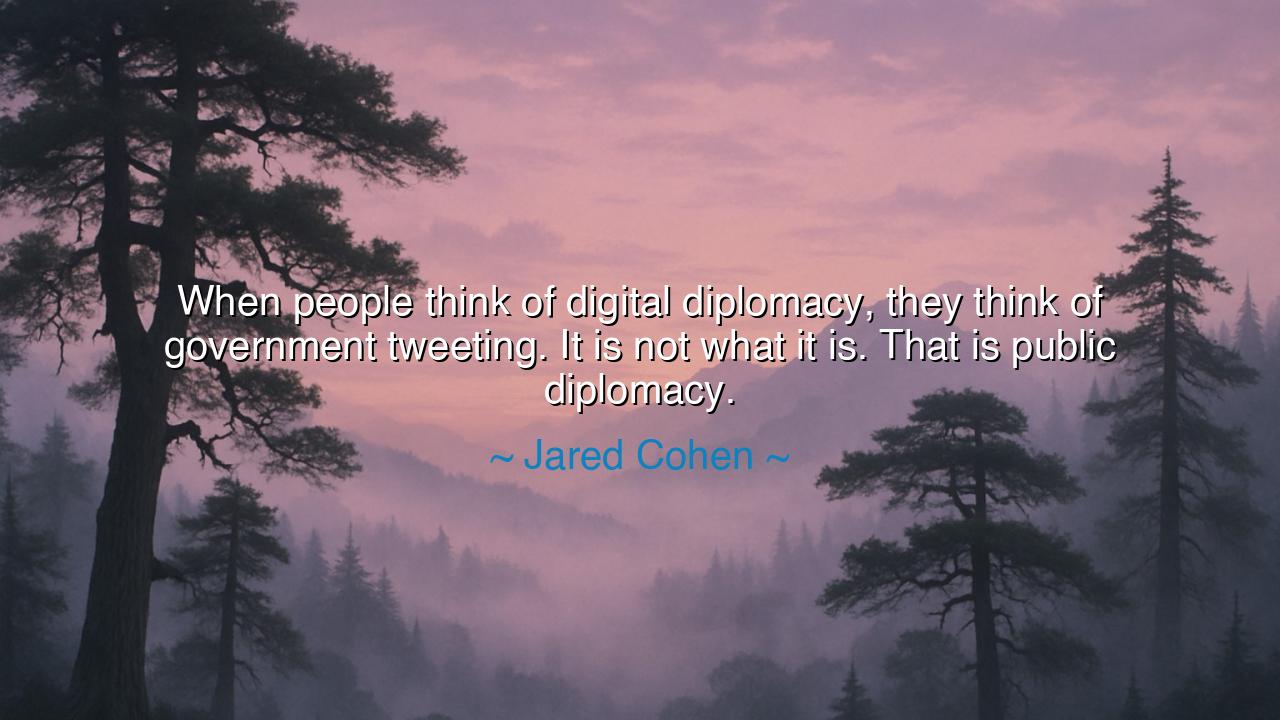
When people think of digital diplomacy, they think of government
When people think of digital diplomacy, they think of government tweeting. It is not what it is. That is public diplomacy.






The words of Jared Cohen, a thinker forged in the crucible of the digital age, carry the weight of a modern oracle: “When people think of digital diplomacy, they think of government tweeting. It is not what it is. That is public diplomacy.” Beneath this statement lies a warning and a revelation—that the true power of technology in governance lies not in the noise of communication, but in the architecture of connection, the unseen threads that bind nations, movements, and hearts in an era where borders grow thinner and voices grow louder. Cohen, who has walked the halls of government and the corridors of Silicon Valley alike, reminds us that diplomacy is not spectacle—it is structure, and that the deepest revolutions are often quiet.
At its core, this quote unveils the difference between performance and purpose. In an age where leaders measure their influence by followers and headlines, the act of diplomacy risks becoming theater—tweets, posts, slogans echoing across the digital void. Cohen’s words cut through that illusion. Digital diplomacy, he tells us, is not about what governments say, but what they build—how they use technology to solve global problems, to respond to crises, to bridge divides that centuries of politics could not mend. The tweet may stir emotion, but the infrastructure—the networks of information, the alliances of cybersecurity, the shared digital systems of peace and progress—those are what sustain civilization.
The origin of this insight lies in Cohen’s own journey. As an advisor to the U.S. State Department and later as the founder of Google Ideas (now Jigsaw), he stood at the frontier where diplomacy met technology. He witnessed firsthand how the digital realm reshapes the language of power—how revolutions no longer require armies, but information; how influence is no longer broadcast, but shared. His experiences during the Arab Spring and in other digital crises revealed to him that governments, while eager to join the social media chorus, often misunderstood the deeper task before them: not to speak, but to listen, not to tweet, but to transform. Thus, his words arose from both wisdom and frustration—a call to maturity in an age of shallow engagement.
History itself echoes Cohen’s distinction between display and substance. In the Cold War era, when propaganda waged war in the hearts of men, it was public diplomacy that dominated—the exchange of symbols, speeches, and ideals meant to shape perception. But behind those public gestures, a quieter and more enduring diplomacy unfolded. Think of the Hotline Agreement of 1963, established between Washington and Moscow after the Cuban Missile Crisis—not a public display, but a digital channel of communication built to prevent annihilation. That was the spirit of true digital diplomacy—technology not used to speak louder, but to think deeper, to save lives. It is this kind of unseen, structural wisdom that Cohen exalts, and which our modern world too often forgets.
Yet Cohen’s words also speak beyond politics—they are a reflection of human nature in the digital age. Just as governments mistake communication for connection, so too do individuals mistake visibility for influence. The world has become addicted to expression, but starved of understanding. The lesson of Cohen’s insight, therefore, extends to every soul who seeks to lead, create, or inspire: impact is not measured by volume, but by depth. The loudest voice is not always the wisest, and the most viral message is rarely the most transformative. True influence—whether between nations or individuals—lies in the patient weaving of trust, collaboration, and truth across the networks we inhabit.
Thus, Cohen’s warning becomes a modern parable: beware the illusion of engagement without effect. Governments may fill the airwaves with words, but if their digital tools do not improve lives, their diplomacy is empty. Likewise, a person may shout their beliefs to the world, but if they do not act upon them, their legacy is dust. The age of digital diplomacy calls not for louder proclamations, but for wiser architectures of cooperation—the use of data, connectivity, and innovation to build peace, prevent conflict, and empower humanity’s shared progress.
The lesson, then, is clear: do not mistake noise for substance, nor expression for achievement. Whether one governs a nation or one’s own small sphere of influence, the art of leadership in the digital era lies in building systems that endure beyond the moment. A tweet fades within hours; an idea that strengthens the world lasts generations. True digital diplomacy, as Cohen teaches, is the noble labor of shaping the unseen forces that will define our collective future.
So let these words be carried forward, like a torch for the modern age: speak less, build more. Let governments harness technology not for applause, but for wisdom. Let leaders understand that the future is not crafted by slogans, but by infrastructure of trust and intelligence. And let every citizen, in their own way, practice the diplomacy of creation—using the digital tools of our time not merely to echo, but to enlighten. For in the end, as Cohen reminds us, public diplomacy is speech—but digital diplomacy is civilization in motion.






AAdministratorAdministrator
Welcome, honored guests. Please leave a comment, we will respond soon